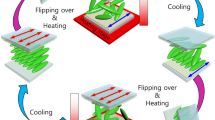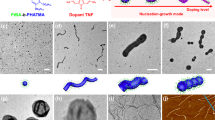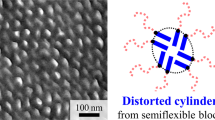Abstract
The liquid crystal (LC) block copolymers composed of side-chain LC polymer (LCP) and polystyrene (PS) segments with various molecular weights and block contents were prepared by atom transfer radical polymerization, and their microsegregated structures were examined for magnetic alignment. Well-aligned samples have been prepared only for the low molecular weight block copolymers with cylindrical microdomains of PS dispersed in the LCP matrix. The prerequisites for perfect alignment of the microdomain structure are (1) coincidence of the disorder-order transition of the microdomain with the isotropic to nematic transition of the LCP segment, and (2) anchoring of the LC mesogen parallel to the microdomain interface. Well-oriented cylindrical and/or anisotropic microsegregated structures are also observed for the mixtures of a LC homopolymer and a LC block copolymer irrespective of extremely low PS segment content of 12–2%. Such persistent formation of anisotropic PS microdomains in the LC field indicates a significant interplay between the microdomain and liquid crystalline structures.
Similar content being viewed by others
Log in or create a free account to read this content
Gain free access to this article, as well as selected content from this journal and more on nature.com
or
References
P. Davidson, L. Noirez, J. P. Cotton, and P. Keller, Liq. Cryst., 10, 111 (1991).
L. Noirez, P. Davidson, W. Scwarz, and G. Pépy, Liq. Cryst., 16, 1081 (1994).
L. Noirez, P. Keller, and J. P. Cotton, Liq. Cryst., 18, 129 (1995).
M. Yamada, T. Iguchi, A. Hirao, S. Nakahama, and J. Watanabe, Macromolecules, 28, 50 (1995).
M. Yamada, T. Itoh, R. Nakagawa, A. Hirao, S. Nakahama, and J. Watanabe, Macromolecules, 32, 282 (1999).
T. Itoh, N. Tomikawa, M. Yamada, and J. Watanabe, Polym. J., 33, 783 (2001).
H. Fischer, S. Poser, and M. Arnold, Liq. Cryst., 18, 503 (1995).
G. Mao, J. Wang, S. R. Clingman, C. K. Ober, J. T. Chen, and E. L. Thomas, Macromolecules, 30, 2556 (1997).
J. Adams and W. Gronski, in “Liquid Crsytal Polymers,” D. A. Wein and C. K. Ober, Ed., American Chemical Society, Washington DC, 1990.
I. W. Hamley, V. Castelletto, Z. B. Lu, C. T. Imrie, T. Itoh, and A. Al-Hussein, Macromolecules, 37, 4798 (2004).
C. Osuji, P. J. Ferreira, G. Mao, C. K. Ober, J. B. Vander Sande, and E. L. Thomas, Macromolecules, 37, 9903 (2004).
N. Tomikawa, Z. Lu, T. Itoh, C. T. Imrie, M. Adachi, M. Tokita, and J. Watanabe, Jpn. J. Appl. Phys., Part 2, 44, L711 (2005).
M. Tokita, K. Tokunaga, S. Funaoka, K. Osada, and J. Watanabe, Macromolecules, 37, 2527 (2004).
S. Kang, M. Tokita, K. Ogino, T. Doi, T. Takahashi, H. Takezoe, and J. Watanabe, Phys. Rev. E: Stat., Nonlinear, Soft Matter Phys., 73, 011701 (2006).
R.-J. Roe, “Methods of X-ray and Neutron Scattering in Polymer Science,” Oxford University Press, New York, 2000.
Author information
Authors and Affiliations
Corresponding author
Rights and permissions
About this article
Cite this article
Adachi, Ma., Takazawa, F., Tomikawa, N. et al. Magnetic Orientation of Microcylinders in Liquid Crystalline Diblock Copolymer and Clarification of Its Orientation Mechanism. Polym J 39, 155–162 (2007). https://doi.org/10.1295/polymj.PJ2006102
Received:
Accepted:
Published:
Issue date:
DOI: https://doi.org/10.1295/polymj.PJ2006102



